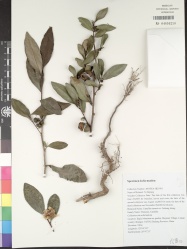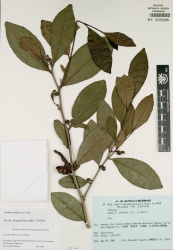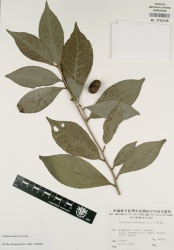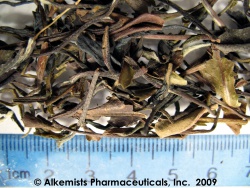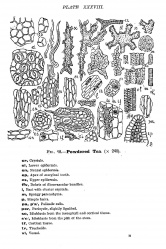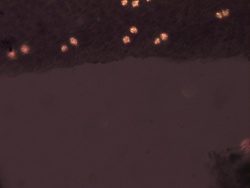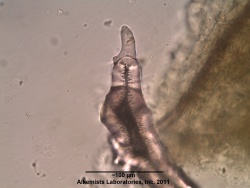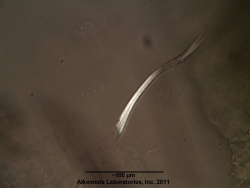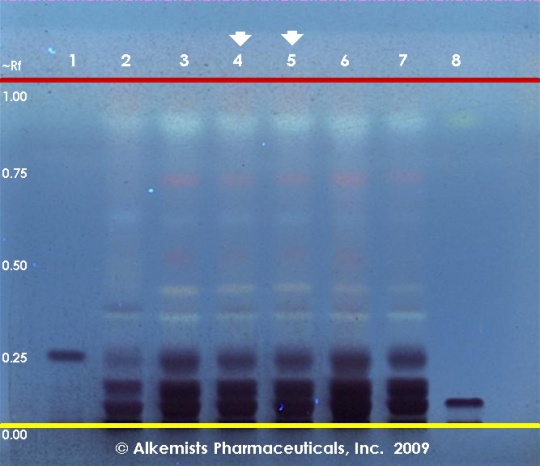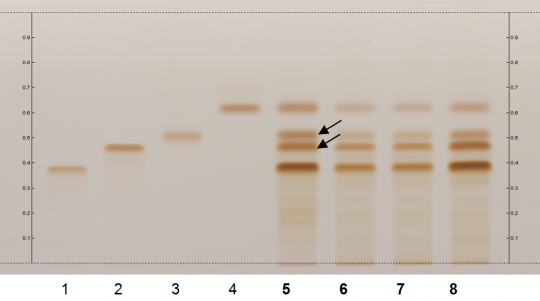Camellia sinensis (leaf)
(to new layout, ref to Herbal Drugs and Phytopharmaceuticals, Wichtl, M., 1994 omitted) |
(Nomenclature updated) |
||
| Line 1: | Line 1: | ||
{{DISPLAYTITLE:''Camellia sinensis'' (leaf)}} | {{DISPLAYTITLE:''Camellia sinensis'' (leaf)}} | ||
=Nomenclature= | =Nomenclature= | ||
| − | + | {{nomenclature | binomial=Camellia sinensis | |
| + | |authority=(L.) Kuntze | ||
| + | |family=Theaceae | ||
| + | |scn=tea | ||
| + | |syn= | ||
| + | |aka=black tea; Chinese tea; green tea | ||
| + | |notes=See text.}} | ||
=Botanical Voucher Specimen= | =Botanical Voucher Specimen= | ||
Revision as of 03:47, 27 February 2014
Contents |
Nomenclature
Camellia sinensis (L.) Kuntze Theaceae
Standardized common name (English): tea
Botanical Voucher Specimen
|
|
|
|
Organoleptic Characteristics
Macroscopic Descriptions
 |
|
|
Microscopic Characteristics
|
High Performance Thin Layer Chromatographic Identification
|
Green Tea (leaf) (Camellia sinensis) Lane Assignments Lanes, from left to right (Track, Volume, Sample):
Reference materials used here have been authenticated by macroscopic, microscopic &/or TLC studies according to the reference source cited below held at Alkemists Laboratories, Costa Mesa, CA. Stationary Phase Silica gel 60, F254, 10 x 10 cm HPTLC plates Mobile Phase CHCl3: ethyl formate: HCOOH [5/4/1] Sample Preparation Method 0.3 g + 3ml 70% grain EtOH sonicated + heated @ 50° C ~ 1 hr Detection Method Vanillin/H2SO4 Reagent -> 110° C 5 min -> UV 365 nm Reference see Herbal Drugs and Phytopharmaceuticals, Wichtl, M., 1994
|
|
Green Tea (leaf) (Camellia sinensis) Lane Assignments Lanes, from left to right (Track, Volume, Sample):
Reference Sample(s) Reference:Individually dissolve 1 mg of (-)-epigallocatechin and 1 mg of (-)-epicatechin gallate each in 20 mL of methanol; Optional: Individually dissolve 1 mg of (-)-epigallo-catechin-3-O-gallate and 1 mg of (-)-epicatechin each in 20 mL of methanol; Store all solutions at -20°C. Stationary Phase Stationary phase, i.e. Silica gel 60, F254 Mobile Phase Toluene, acetone, formic acid 9:9:2 (v/v/v) Sample Preparation Method Sample: Mix 100 mg of powdered sample with 10 mL of methanol, water 4:1 and sonicate for 10 minutes, then centrifuge or filter the solutions and use the supernatants / filtrates as test solutions. Derivatization reagent: Fast Blue salt B reagent; Preparation: dissolve 140 mg of Fast Blue salt B in 10 mL of water and add 140 mL of methanol and 50 mL of dichloromethane. Store reagent in the dark at 4°C; Use: preheat the plate to 100°C for 2 min, then dip (time 0, speed 5), dry for 5 min in the fume hood. Detection Method Unsaturated chamber; developing distance 60 mm from lower edge; relative humidity 33% Other Notes Images presented in this entry are examples and are not intended to be used as basis for setting specifications for quality control purposes. System suitability test: (-)-Epigallocatechin: brown zone at Rf ~ 0.46; (-)-Epicatechin gallate: brown zone at Rf ~ 0.52 Identification: Compare result with reference images. The fingerprint of the test solution is similar to that of the corresponding botanical reference sample. Additional weak zones may be present. The chromatogram of the test solution shows four brownish-orange zones corresponding to reference substance epigallocatechin-3-O-gallate (Rf ~ 0.37), (-)-epigallocatechin (Rf ~ 0.46), (-)-epicatechin gallate (Rf ~ 0.52), and (-)-epicatechin (Rf ~ 0.62). The lowest zone is the most intense and the upper zone is the faintest. The two zones in between are clearly separated (black arrows).
|
Supplementary Information
Sources
- ↑ Tropicos.org. Missouri Botanical Garden. 13 Sep 2013 <http://www.tropicos.org/Image/30076>
- ↑ Tropicos.org. Missouri Botanical Garden. 13 Sep 2013 <http://www.tropicos.org/Image/30070>
- ↑ Tropicos.org. Missouri Botanical Garden. 13 Sep 2013 <http://www.tropicos.org/Image/30074>
- ↑ Elan M. Sudberg, Alkemist Laboratories http://www.alkemist.com
- ↑ Greenish, H. et. al. (1908) An Anatomical Atlas of Vegetable Powders
- ↑ Greenish, H. et. al. (1908) An Anatomical Atlas of Vegetable Powders
- ↑ Amy Brush, Traditional Medicinals
- ↑ Elan M. Sudberg, Alkemist Laboratories http://www.alkemist.com
- ↑ Elan M. Sudberg, Alkemist Laboratories http://www.alkemist.com
- ↑ Elan M. Sudberg, Alkemist Laboratories http://www.alkemist.com
- ↑ HPTLC Association http://www.hptlc-association.org/
